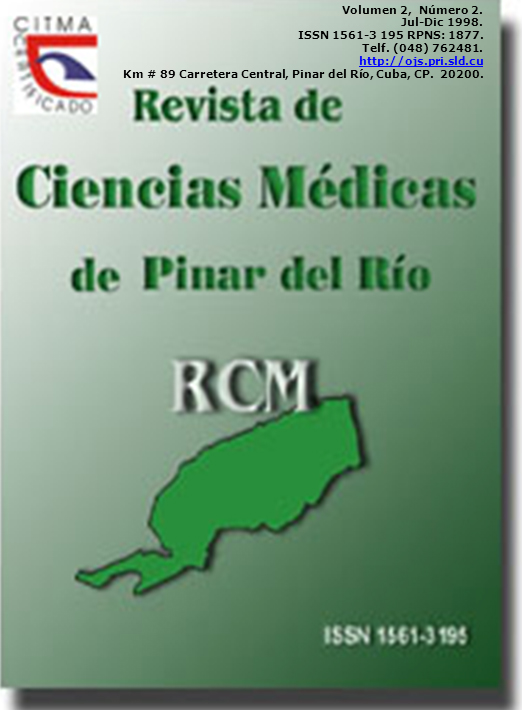Función aspirativa con aguja fina en tumores de torax y abdomen. Needle Aspiration Puncture for Thoraxic and Abdominal Tumors
Abstract
Se realizó un estudio descriptivo a una muestra constituida por 89 pacientes que acudieron al servicio de radiología del Hospital Docente "Abel Santamaría" de Pinar del Río, siendo portadores de una lesión de aspecto tumoral de tórax o abdomen, ya fueran estas palpables o diagnosticadas por radiografía y/o ultrasonido con el objetivo de evaluar la utilidad de la punción aspirativa con aguja fina, como método diagnóstico, a estos pacientes se les realizó una punción aspirativa con aguja fina, en el periodo comprendido entre el 1 de octubre de 1991 al 31 de mayo de 1997. Obtuvimos 90 muestras útiles, y de estas 62 resultaron verdaderos positivas (69.6%) y 7 fueron verdaderos negativos (7.8%) hubo también 5 falsos y 3 falsos negativos. Se hizo además una descripción de la técnica utilizada y se analizó la utilidad de las muestras (según el método imagenológico empleado y las complicaciones presentadas durante el estudio. Para comprobar la eficiencia del proceder correlacionamos los resultados citológicos con los histológicos obtenidos por otros medios. Calculamos la sensibilidad, especificidad, índices predictivo positivos, negativos y fracción positivo. Se concluyó que este proceder de gran valor diagnóstico que tiene un bajo costo escasas complicaciones y es fácil de realizar por un personal debidamente entrenado.
DeCS: BIOPSIA CON AGUJA, NEOPLASMA ABDOMINALES/diagnostico, NEOPLASMA TORAXICAS/diagnostico.
A sample of 89 patients with an abdominal or thoraxic tumor-like injury (detected on physical examination or through x-ray and/or ultrasound) was included in a descriptive study aiming to evaluate the usefulness of the needle aspiration puncture as a diagnostic method. The study was carried out in the Radiology Department at Abel Santamaria General Hospital between October 1, 1991 and May 31, 1997. The patients were submitted to a needle aspiration puncture obtaining 80 useful samples; 62 were true positive (69.6%), 7 were true negative (7.8%), 5 were false positive and 3 were false negative. A description of the technique was made. The complications during the study and the usefulness of the sample, according to the imaging method, were also analyzed. The efficacy of the procedure was proved through the correlation established between cytologic and histologic methods obtained through different means. Sensitivity, specificity, negative and positive predictive indexes and false negative fraction were estimated. It was concluded, this procedure has a great diagnostic value and significant advantages such as a low cost, and few complications. Besides, it is an easy method to be used by a properly trained staff.
DeCS: BIOPSY NEEDLE, ABDOMINAL NEOPLASMS/diagnosis, THORACIC NEOPLASMS/diagnosis.
Downloads
How to Cite
Issue
Section
License
Authors who have publications with this journal agree to the following terms: Authors will retain their copyrights and grant the journal the right of first publication of their work, which will be publication of their work, which will be simultaneously subject to the Creative Commons Attribution License (CC-BY-NC 4.0) that allows third parties to share the work as long as its author and first publication in this journal are indicated.
Authors may adopt other non-exclusive license agreements for distribution of the published version of the work (e.g.: deposit it in an institutional telematic archive or publish it in a volume). Likewise, and according to the recommendations of the Medical Sciences Editorial (ECIMED), authors must declare in each article their contribution according to the CRediT taxonomy (contributor roles). This taxonomy includes 14 roles, which can be used to represent the tasks typically performed by contributors in scientific academic production. It should be consulted in monograph) whenever initial publication in this journal is indicated. Authors are allowed and encouraged to disseminate their work through the Internet (e.g., in institutional telematic archives or on their web page) before and during the submission process, which may produce interesting exchanges and increase citations of the published work. (See The effect of open access). https://casrai.org/credit/



